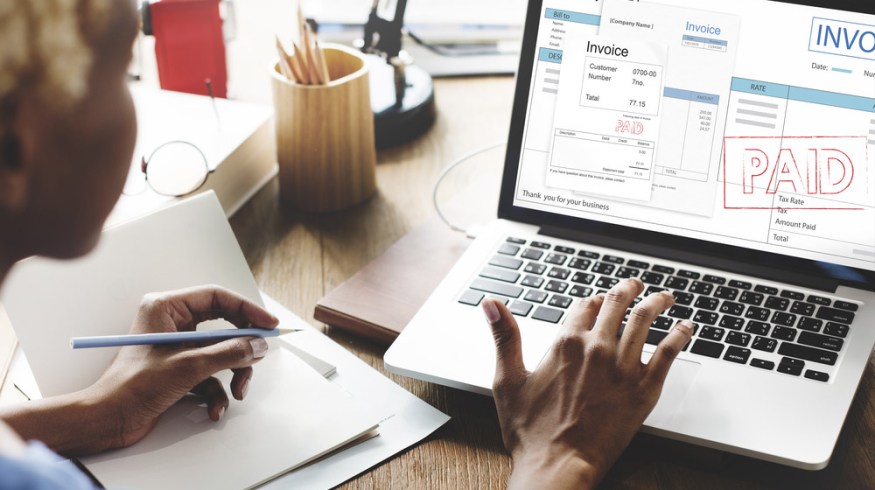
Freelance Tips: 7 Best Practices for Invoicing Clients
Invoicing clients doesn’t have to be scary. Follow these seven best practices to make your invoices clear and professional.
Cover image via Rawpixel.com.
In a perfect world, once a freelance video project is wrapped, clients would be all too happy to hand over a stack of cold, hard cash (along with a gift basket from Lands’ End including several seasonally appropriate fleeces). However, in the real world, that’s very rarely the case.
Most of the time, the onus falls on the freelancer to deliver an invoice at the most appropriate time. This isn’t always at the very end of a project because some projects seem to simply never end. In any case, creating a detailed, professional, and direct invoice can help move things along and define how, when, and how much your clients should pay for your hard work.
Let’s look at seven best practices for freelance video invoices.
1. Find the Right Template

Image via StarLine.
You can always make an invoice from scratch. Simply typing something up in a word processor is fine, but if you have some design chops, you can whip one up on your own with your own branding, logos, etc.
For the rest of us less design-minded individuals, there are plenty of templates available online. You can find some for Microsoft Word, Google Docs, and Apple Pages. They should all be mostly the same, but they should have some variations in spacing and layouts. Choose the one that gives you the most flexibility and the right aesthetic for your brand.
2. Define Project Scope

Image via baranq.
Ideally, you should define project scope well before diving into production (or post-production, if it’s strictly an editing gig). A contract or statement of work well help define these things upfront. (You can read more about these things here.) However, when submitting an invoice, it’s important to restate, point-by-point, the agreed-upon scope — and that you have now completed each task.
3. Line Item vs. Full Amount

Image via wutzkohphoto.
Most invoice templates accommodate line item pricing breakdowns. These templates will also usually add up the totals for you. However, depending on your project, you may or may not want to use line item (or unit item) pricing; rather, you can just list full amounts.
Film and video invoicing gets tricky when you start line item pricing things like gear rentals, hourly editing rates, and incurred expenses. However, while an invoice page can fill up, I’ve found that clients appreciate the line-by-line breakdown of just how you arrived at those numbers.
Things like camera and gear rates are important to include, as many clients can quickly change the conversation to suggest that your camera/gear is somehow just a part of what you charge to show up and shoot.
If you have agreed to a lump sum project that is not set to change, using a line item breakdown to add up your actual worth (then subtracting a discount to honor your original agreement) is a great way to show how much your services will cost in the future, while still fulfilling your agreement.
4. Clearly Defined Dates of Completion

Image via This Is Me.
When working with bigger companies and agencies (i.e. clients who are also working for clients), clearly defined completion dates for deliverables becomes more important (as they need to pass those dates onto others in their organizations). Most invoice templates will include a space to add notes — this would be where you can list clear dates. Here’s an example:
- Half-Day B-Roll Shoot — completed 10/2/17
- Interview Shoot — completed 10/3/17
- Raw Footage and Assets — delivered via Dropbox 10/4/17
- Final Video (w/ revisions) — delivered via Vimeo 10/14/17
5. Download Links and Files
It also helps to include final links for all your files and deliverables with your invoice (either in the notes or in your invoice email). If you haven’t discussed a fee for archiving and preserving files, you can set up downloads for a final consolidation of all necessary assets and footage by using Dropbox, WeTransfer or Vimeo.
You can take this opportunity to suggest they download all footage and assets within seven days (or whatever your file-hosting website encourages), as you will not be able to keep them longer than that. (If your client has additional concerns, you can work something out.)
6. Include W-9

Image via Zodiact.
Film and video professionals operating in the United States working on any project (or projects) that add up to over $600 in a calendar year need to fill out a W-9 tax form listing the “employer.” Both parties will need this form for their taxes. Your client will probably send this to you eventually, but many larger agencies won’t even submit your invoice until they get your W-9.
To jump-start the process, keep a W-9 form already filled out to send over with your invoice. Some companies may ask for one that includes their information, but they might just add that themselves. Just be sure to update this every year.
You can read more about W-9 forms here, and download a copy here.
7. State an Expected Due Date (but recognize protocol)

Image via Jamesboy Nuchaikong.
You may also notice that many invoice templates have a spot for a due date. You might feel that something like this is unnecessary (and would undermine trust), but if you’re working with professionals, they should appreciate your expectations — and therefore be quick to let you know if they can’t meet them.
Ideally, it’s best when freelancers can ask for half of a project’s payment up front in the form of a deposit. But if you’re working toward an invoice-upon-delivery method, giving a range from two to six weeks is the industry standard. They very well could deliver payment quicker, but in many larger organizations, invoice billings get passed off to a financial team that may have its own protocol (which can sometimes be 30 to 60 days). Find out when you’re discussing the scope of work so you’ll know what to expect.
Bonus: More Free Templates!

Image via Dragan Grkic.
- 100 Free Invoice PDF Templates
- Invoice Templates | FreshBooks
- Free Invoice Templates For Word, Excel, Open Office
- Free Video Production Invoice Template
- Video production Invoice Template
And for more articles, information, and resources for freelance film and video production, check out some of these links.






